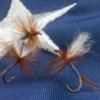-
Content Count
937 -
Joined
-
Last visited
Community Reputation
0 NeutralAbout WYKnot
-
Rank
Advanced Member
- Birthday 12/28/1956
Contact Methods
-
Website URL
http://
-
ICQ
0
Profile Information
-
Location
Wyoming
Recent Profile Visitors
3,389 profile views
-

What's the best aperture size for photographing flies?
WYKnot replied to djgunter's topic in Photography Corner
Lots of good advice to your question on aperture. As noted, the depth of field is so critical when shooting macro, you need to be very precise when you focus. Try mounting a bare hook and taking a series of photographs, critically evaluate your images...are the hook eye and hook point both in focus? Aligning the camera sensor (film plane) paralelle to the hook shank takes practice and plenty of trial-and-error. If you search the archives of the Photography Corner, you can find a series of replies and comments, particularly from AL Beatty, that cover a number of tips and tricks for macro photography...to include apetures, DOF, and critical focus. I common shoot flies at f/22-f/36, but experimented a lot before getting images print and web editors accepted. I use a Nikkor 60mm micro (Nikon's term for macro) when shooting for detail and use a homemade "fly studio" with a grid pattern on the surface to help consistenly achieve good alignment and a tubular cage to mount multiple lights. You may not need, or want, to get this obsessive, but it certainly helps get reproducilbe images. Take lots of photographs and edit ruthlessly, the process of discovery is great fun! -
Sometimes a mordant will help, especially with water based dyes. I used 2 iron supplement tablets (dietary supplements from the vitamin rack) in a cup of warm, dilute vinegar. The 50:50 mix sounds about right. Pure washing with soapy water is also excellent advice.
-
What a setup Steve! The cylindrical morph drive (aka lava lamp) is a must-have on any intergalactic vessel. I have been sketching some design ideas, looking at how I might layout the laptop and monitor, capture the most usable space, and keep everything handy. Thanks, best for the holidays.
-
Another tip on the backdrop: keep it far enough behind the fly that is stays out of focus when you shoot in macro mode. This creates a soft, consistent background and helps isolated the details of a sharply focused fly. I am posting from an iPad and have not figured out how to insert pictures into a reply. If you would like, take a look at the article posted on Hatches Magazine ( link below). Notice the flies in the lead photo lose detail against a cluttered back ground, but the flies highlighted against a soft blue background sweep show much more detail. Keep experimenting, it is a lot of fun. http://hatchesmagazine.com/blogs/Hatches/2010/09/07/talking-turkey-to-a-trout-by-russ-forney/
-
Thanks for the idea, Al, might be a more reasonable solution for now.
-
Neat shot, Steve, very warm colors.
-
Does anyone have experience with dual monitor support arms? I am looking for a desk-mounted set-up to hold a laptop and extra monitor in side-by-side (or adjacent) positions. I have looked at offerings by Atdec and Ergotron on the web, hoping for some feedback before making an investment. My job requires frequent travel, hence the laptop for writing and culling photographs. I like to link to a full size monitor to process photos when home and take advantage of dual display options, better image quality, and a larger screen (for well-worn eyes). My needs are a solid platform that does not vibrate or sag over time (monitor or laptop slowing sinking), articulated arms, and VESA mounts. Thanks in advance for your comments. Russ
-
You have gotten some great tips Bryan, a couple of things to think about: Depth of Field (DOF) is extremely limited under macro conditions, once you get to 1:1 or greater magnification, DOF is paper thin. Be sure your fly is parallel (same focal plane) as your camera sensor in order to capture as much of the pattern in acceptable focus as possible. The same holds true is you plan to take photos of tying steps; keep mateirals in the same plane if you want them to be in focus. Try mounting a hook in your vise and vary the camera angle until you get both the eye and point in crisp focus. It is a good way to learn about DOF, camera angle, and lighting. If critical focus is your intent, try shooting in aperture priority mode. I also shoot from a tripod and use manual focus. I have found a sheet of medium blue closed cell foam makes a handy background: easy to manipulate in Photoshop, user-friendly to most auto-exposure systems, and provides a uniformly lit surface. Experiment, be creative, and have fun!
-
I'd guess Spearfish Creek below the canyon.
-
Thank you both, it is a beautiful stream, even more so when the caddis come off and get the trout all excited.
-
Shell Creek runs through the Big Horn Moutains in northcentral Wyoming, water is still a bit off color from snow melt, but spring is coming fast to the high country.
-
How is it that trees are blooming in Michigan Steve? We had another couple of inches of snow today; May is a winter month in Wyoming.
-
Nice pics Chris, the little one in the walker looks mighty happy.
-
Or you could use 'WaterMark Flies' The only advice I could offer, beyond that already provided, is find a good day job; selling flies is not likely to pay the bills. It is fun, creative, and introduces you to some great people.
-
Clever design and very functional. Enjoyed your web photos, thanks for supporting Project Healing Waters.

